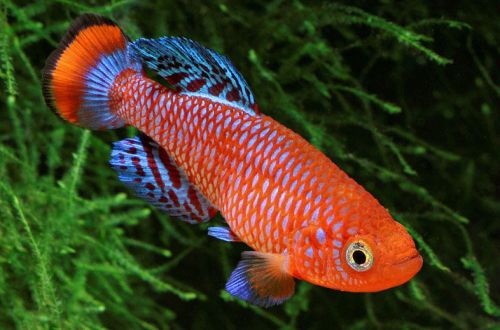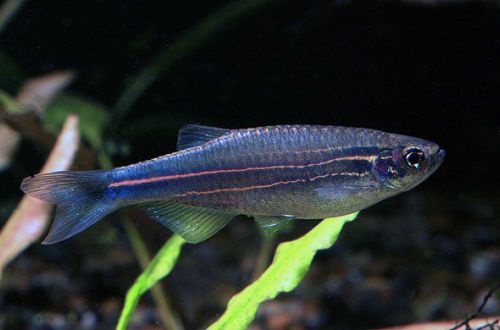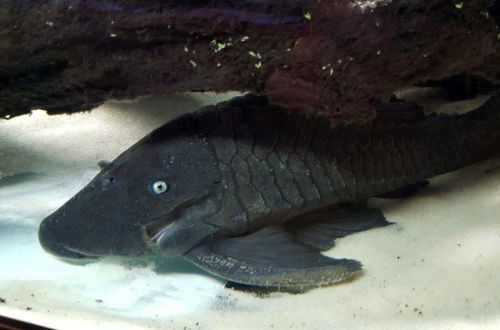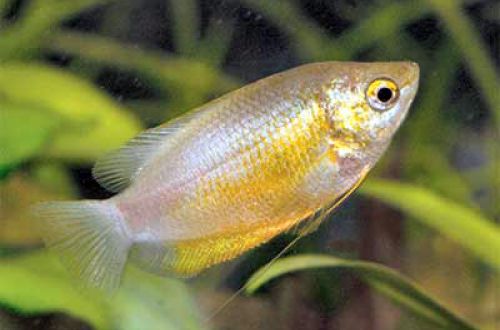
Notobranchius Rakhova
Nothobranchius Rachova, scientific name Nothobranchius rachovii, belongs to the Nothobranchiidae family. A bright and beautiful fish, one of the most colorful representatives of Killy, and at the same time it is not at all whimsical in content. However, this beauty has one drawback – a short lifespan, which in its natural habitat rarely exceeds one season, although in an aquarium it increases by a couple of years.

Habitat
Originally from Africa from the territory of modern Mozambique. Inhabits small reservoirs, swampy areas of the floodplain of the Zambezi River in the flat part. Water levels tend to drop markedly during the dry season, or bodies of water dry up completely for several months each year. At this time, all adult fish die, representatively having time to lay eggs in the ground, which remains viable until the first rains.
Description
The modest size of the fish is more than offset by bright colors. Males grow larger than females and are more colorful. Depending on the region of origin, the color scheme varies from bright fiery to blue. In all cases, both shades are present to a greater or lesser extent.
Often, when different morphological forms were kept together in aquariums, hybridization occurred, the color became mixed, and it is not easy to find the true variety. Professional breeders strive to preserve the individual color features of each variety, and for this purpose, in commercial collections, certain clarifying marks are added to the name.
Food
The basis of the diet should consist of live or frozen food in the form of daphnia, brine shrimp, small bloodworms, etc. Dry food is used only as supplements. Feed 2-3 times a day in the amount eaten in 5 minutes, the remnants of the meal should be removed.
Maintenance and care
One pair of Notobranchius Rakhova will feel great in a tank from 50 liters with dense vegetation, located in groups along the side and back walls of the aquarium, with sandy soil. The remaining design elements are placed based on the preference of the aquarist.
The composition of the equipment consists of a standard set: filtration, lighting, heating and aeration systems. The fish come from calm stagnant reservoirs, so the internal current is contraindicated, its main source in the aquarium is the filter, so make sure that the flows of water coming out of it are scattered about some kind of obstacle (glass, large stone or snag).
The composition of the water is characteristic of most swamps – soft, slightly acidic. More about pH and dGH parameters in the section “Hydrochemical composition of water”. Weekly maintenance is reduced to replacing part of the water (10–15% of the volume) with fresh water, periodically cleaning the glass and soil from organic residues.
Behavior and Compatibility
This species is compatible with many peaceful calm fish of a similar size, however, it should be borne in mind that maintaining the population requires the annual cultivation of a new generation, and for some species it is common to get used to the neighbors in the aquarium, and their constant renewal provokes unnecessary stressful situations. Therefore, Notobranchius Rakhov is recommended to be kept together with his relatives for the purpose of breeding.
Breeding / breeding
Promoting the emergence of a new generation of fish is perhaps the main goal of any aquarist, especially dealing with such a unique species. Notobranchius usually lives for about a year, during which time he manages to go through all the stages of development from fry to an adult sexually mature individual.
Spawning is preferably carried out in a separate tank, where peat or coconut fiber-based filler is used as the soil, the female lays eggs directly into the substrate. The set of equipment includes a heater and a lighting system, nothing else is required.
Adult fish are placed in a spawning tank and the temperature is gradually raised above 24°C as the water level drops. This stimulates the start of the mating season. When the female lays eggs, and the male fertilizes it, the fish are placed back into the common aquarium, but not immediately, but with the temperature equalizing. Returning to the previous conditions often increases life expectancy.
Water is drained from the spawning aquarium, the substrate with eggs is taken out and left in a dark, warm, but dry place at a temperature of 21–25 ° C for several months (3–4). Then the substrate is again immersed in water and after a while fry appear. They grow very quickly and soon they can be placed in a community aquarium.
It is worth noting that after each cycle it is necessary to change males or females (purchase new ones) in order to dilute the genetic material. Constant crossing between close relatives from the same brood will lead to the degeneration of the species.





